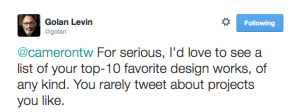sTechs
STS is diverse, so I’m mainly talking about sociologies of technology development; the Latour of Aramis rather than Laboratory Life, Akrich and Bijker, etc. The ‘research subjects’ in those cases are mostly engineers – mechanical and electrical engineers who don’t really think about technology development as design, or think of design as conflicting constraint management (engineering schools have only recently started teaching ‘design’ in the art school sense, and in most cases this is ‘design thinking’ not designing).
It is always frustrating to me how often those sociologies of technology seem to be talking about design without ever using the word or talking to the designers who were probably involved in the process.
My gossip understanding is that when Latour was asked to keynote the design history conference, he got his understanding of design from Sloterdijk who teaches at an Art and Design School. The paper (Cautious Prometheus) is great, but the suit is many sizes too big for practicing designers. Subsequently, Latour has worked with actual designing designers on visualizing controversies, etc, but I’ve not seen him actually talk of the design process.
Design
Design is diverse, so I’m mainly talking about non-architectural, human-scale artifact. There is strong sTechs work about architecting, such as Yaneva. Human-scale artifacts means for me Product Design, Fashion Design, Communication Design, some Interior Design, Service Design. For non-designers, especially #designthinking types, it is difficult to comprehend how distinct, and even incompatible, are the processes deployed by these designers even though they are all making ‘things’ (even if immaterial) of use.
Another thing non-designers, especially from other disciplines, don’t often get is that human-scale artifact design has been colonized by HCI and interaction design. Because computer science deliberately pursued establishing itself as a science, and so a discipline, with research publications as the primary measure of success, people doing applied research on digital technology development found themselves doing design, but found almost no literature on designing (other than Don Norman’s not so rigorous cog sci) so swamped in defining what ‘research of design’ entailed. The behemoth that is CHI still produces next to nothing of interest to what I call human-scale artifact designers, but google scholar design and you’ll only find CHI stuff.
The reason there is little by way of research in design is that design (on the art school side rather than engineering side) has and continues to be taught by doing. Designers teach design by getting would-be designers to design – in studios. As I tried to say in “Design Studies – What is it Good for?,” Design Studies remains missing from a lot of design teaching. In the US, the liberal arts side of design degree is of and by liberal arts. There is outside the US, some, but still very little, research of design beyond perfunctory design history, taught to designers. Design Studies research, as a sub-discipline, is aspirational at best. There is therefore little chance of Design Studies impacting sTechs when it can’t even impact CHI. A similar thing has happened in the Digital Humanities where Humanities people discovering the power of ‘research through design’ – coming to know through creative information visualisation – for example, start doing (very bad) design without any acknowledgement that there is a whole discipline and profession for doing this well (graphic design, visual communication design, information visualisation design). Anne Burdick has been fighting that good fight.
Design < > sTechs
On the odd occasion I’ve managed to get designers to read Latour, Akrich, Bijker, etc, on technical product development, there is the kind of reaction that says: “der, of course, how can you publish such obvious stuff, oh, I see, academia is always heavily jargonised accounts of the bleeding obvious.” What is puzzling to non-designers, that you can construct things, that you can make real what you make up (Scarry’s nice phrase, I’ll come back to), that you can modify people by modifying the form of their things, that social constructivism can be done, that you might need a whole Latourian manifesto called ‘compositionism,’ is not at all puzzling to designers since it is their everyday practice.
If there were more good case study articulations of designers designing (rather than self-serving picture books), this would make a big difference to sTechs I reckon. Though often also architectural, much of the too-positivist work done by the Design Thinking Research Symposium (nothing to do with #designthinking) should be required reading for sTechs folks: Bryan Lawson, Kees Dorst, Gabriela Goldschmidt, Nigel Cross, etc.
To my mind, the best account of artifact making is that of Elaine Scarry in the final chapter of her _The Body on Pain_. Given that Scarry is a kind of literature philosopher, it is interesting that those who understand the making of fiction are so rarely taken up by Design Studies (though see Yelavich’s book a couple of years ago) or sTechs.
An interesting story in that regard is that Buchanan, who founded the more design cultural studies journal, Design Issues (because Design Studies was already the title of the more cog sci of design journal), came to influence and be influenced by, people in the English Department at CMU, who had a very design-based approach to English: understanding composition as an interaction design task – see Dave Kaufer’s Designing Interactive Worlds With Words: Principles of Writing as Representational Composition.



You must be logged in to post a comment.